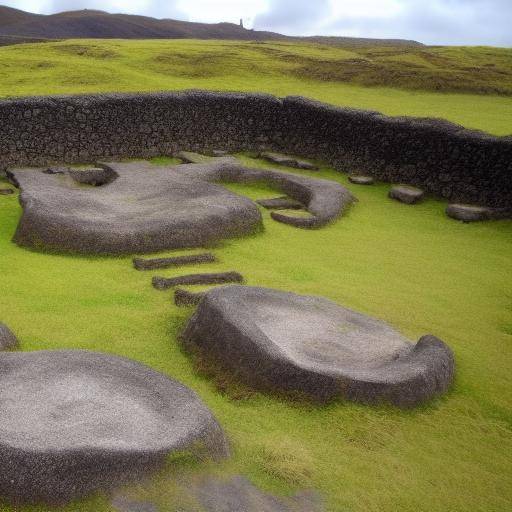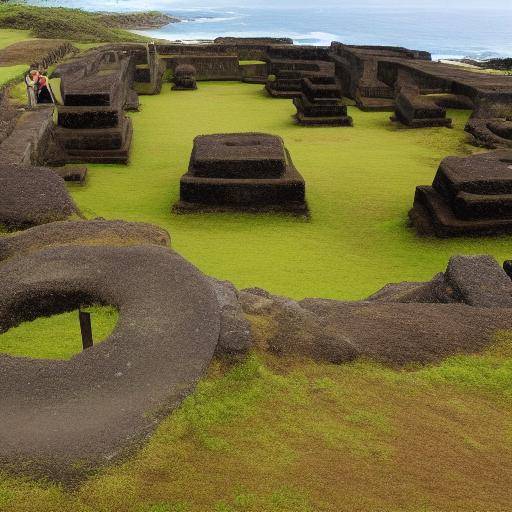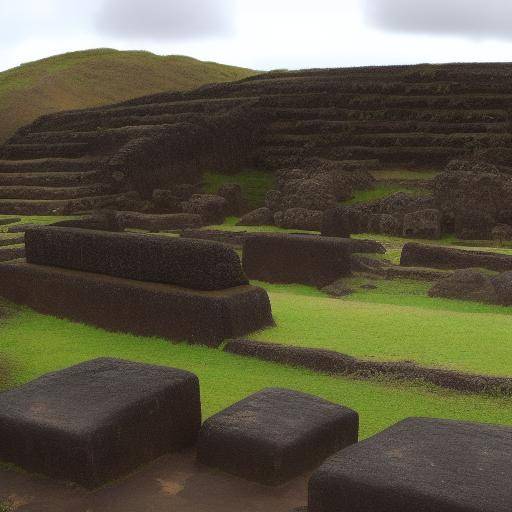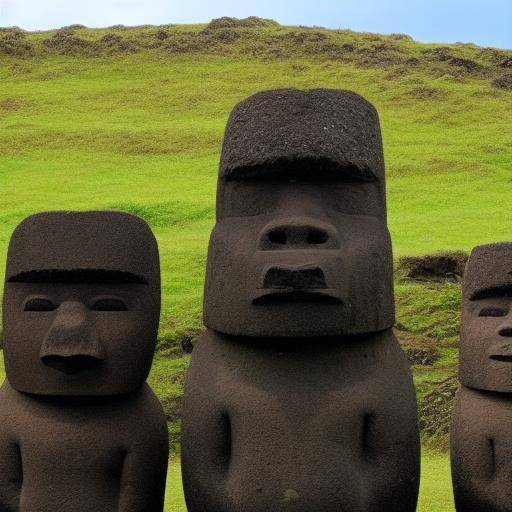
The majestic Easter Island, located in the middle of the vast Pacific Ocean, is known for its mystery and enigma, largely due to the presence of the imposing stone statues known as mois. These monumental stone figures, carved with an amazing skill, have captivated the imagination of people from around the world. In this article, we will explore in depth the history, meaning and cultural relevance of Mois in the context of the Easter Island and its relationship with Chile.
Introduction
The Easter Island, called Rapa Nui by its original inhabitants, is a remote Polynesian enclave that houses one of the most fascinating archaeological legacy of humanity: the Mois. These imposing stone statues, sculpted centuries ago by the Rapa Nui culture, are silent witnesses of an ancient civilization that has left a profound mark on the history and collective imagination. Throughout this article, we will immerse ourselves in the intricate network of cultural, historical and archaeological meanings that surround these majestic figures.
History and Background
The origin of the Mois dates back to the dawn of the Rapa Nui culture, whose first remains date from the first millennium of our era. These impressive sculptures were carved from a volcanic rock known as toba, which is in a quarry in the crater of the Rano Raraku volcano, the main quarry for the production of mois. As we deepen the history of Easter Island, we find the enigmatic expansion and decline of Rapa Nui civilization, whose legacy endures in the impressive ceremonial and enigmatic structures of rongo inscriptions that have puzzled archaeologists and linguists for centuries.
The evolution of the Mois over the centuries reveals to us a dynamic account that spans from the early stage of carving and transporting the statues to the various styles and meanings associated with them. The symbolism and the role of the Mois have been the subject of intense scrutiny, which reveals their intimate connection with the religious beliefs and the socio-political structures of Rapa Nui society, offering a unique window to a culture that has challenged the historical conventions.
Analysis in Deep
As we enter the deep analysis of the Mois, we face a complex embedded in archaeological, anthropological and artistic aspects ranging from carving and transport technique to contemporary interpretations of their meaning. We enter into the ceremonial practices associated with the Mois, the symbolic elements they embody, as well as their relevance in the cultural and spiritual context of Rapa Nui civilization.
In addition, we will analyze the contemporary challenges facing these stone monuments, from preservation and conservation to their role in promoting sustainable tourism and respect for the cultural heritage of Easter Island. At the same time, we will explore the technological and scientific innovations that are shedding new light on the production and meaning of Mois, driving the borders of archaeological and cultural knowledge.
Comprehensive review
In our comprehensive review, we will immerse ourselves in the many applications and approaches that enrich our understanding of the Mois and their resonance in the contemporary world. From the unraveling of their archaeological puzzles to the promotion of cultural awareness and intercultural dialogue, the Mois continue to inspire a diverse range of perspectives that enrich our common cultural heritage.
Comparative analysis
When comparing Easter Island, the Mois and Chile as a whole, a fascinating panorama emerges that highlights the interconnections between these elements. The historical and cultural wealth of the Easter Island is intertwined with the heritage of the Mois, projecting a multifaceted image that transcends geographical and temporal borders. Similarly, the influence of Rapa Nui culture on the cultural mosaic of Chile allows us to appreciate the diversity and complexity of a legacy that persists in national identity.
Practical Tips and Accessible Recommendations
For travelers and lovers of history, Easter Island and its iconic mois offer a unique and unforgettable experience. We recommend exploring these archaeological treasures with due respect and consideration for their cultural and spiritual significance. When visiting the island, it is important to support sustainable tourism initiatives that promote the preservation and respect for the integrity of this unique heritage.
Perceptions of Industry and Expert Reviews
The impressions and opinions of experts in archaeology, anthropology, heritage conservation and sustainable tourism give light on the importance of preserving and promoting the understanding of Mois and Rapa Nui culture. Their valuable perceptions enrich our knowledge and guide us towards greater appreciation for the richness of this ancestral legacy.
Case Studies and Real Life Applications
Through detailed case studies, we explore the various ways in which Mois have influenced the collective imagination and inspired multiple artistic, academic and social expressions. These illustrative examples give us a look at the multiple facets of his legacy, from his aesthetic dimension to his influence on popular culture.
Future Trends and Predictions
In reflecting on the future of Easter Island, the Mois and their connection with Chile, we see a horizon in which the preservation of cultural heritage, intercultural dialogue and sustainable tourism will play a crucial role in promoting the understanding and appreciation of these ancestral relics. Emerging trends invite us to consider the legacy of Mois as a shared legacy of humanity, rooted in history but open to new interpretations and meanings.
Conclusion and Frequently Asked Questions
In conclusion, the Mois and Easter Island invite us to a journey in time and in spirit, where the ancient wisdom of the Rapa Nui culture continues to resonate in contemporaneity. By navigating the historical, cultural and archaeological facets of the Mois, we enter a fascinating universe that reminds us of the transcendence of our shared legacy as human beings.
Frequently asked questions
**What do the Mois represent for Rapa Nui culture?**The Mois are representations of venerated ancestors and tribal leaders of Rapa Nui culture. It is believed that they embody the connection between the earthly and spiritual world, serving as guardians and protectors of the community.
**How were the Mois transported and erected?**The transport and erection of the mois involved an elaborate process combining cutting techniques, displacement and erection. By using stone tools and complex pulley and string systems, the Nui Rapa managed to move these colossal statues from the quarry to their final sites.
**What is the meaning of mois' tocquers?**Touches, known as pukao, represent a manifestation of status and hierarchy among the Mois. Its conical shape and reddish colour symbolize both social distinction and sacred traits associated with the honored ancestors.
**What is the impact of tourism on the preservation of the Mois?**Sustainable tourism plays a crucial role in preserving the Mois by promoting cultural awareness and supporting conservation initiatives. However, the increase in tourism also poses challenges in terms of preservation and responsible management of archaeological sites.
**What is the relationship between the Mois and the cultural identity of Chile?**The Mois represent a central element in Chile's historical and cultural narrative, particularly its island territory on Easter Island. This connection enriches Chile's cultural diversity and promotes intercultural dialogue among its diverse communities.
**What scientific research are shed new light on the mois?**Current research covers various fields, from geology and archaeology to heritage conservation. Studies on the composition of rocks, carving techniques and ceremonial practices associated with mois are contributing to a deeper understanding of these monuments.
**How are the traditions related to Mois presently celebrated on Easter Island?**The traditions related to Mois remain an integral part of the cultural identity of Easter Island, manifesting itself through festivals, ceremonies and artistic expressions that honor the heritage of Rapa Nui culture.
**How does climate change affect the preservation of mois?**Climate change poses significant challenges for mois conservation, particularly for erosion caused by phenomena such as acid rain and ocean acidification. The preservation of these monuments requires adaptive strategies that address environmental impacts.
In short, the Easter Island moans embody a fascinating legacy that transcends the barriers of time and culture, reminding us of the wealth of our common heritage. By understanding its meaning and appreciating its beauty, we can forge a lasting connection with an ancient civilization that challenges us to preserve and honor its legacy in the present and the future.



